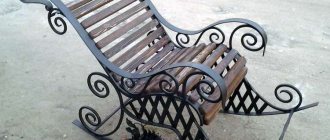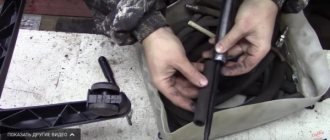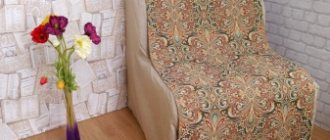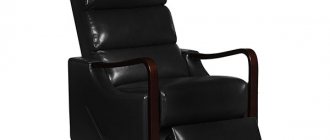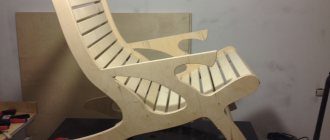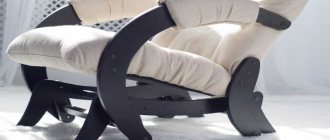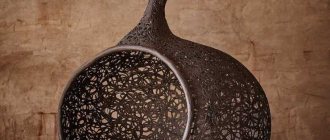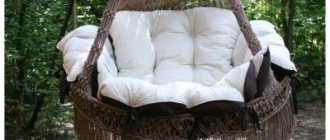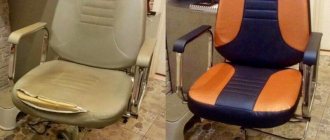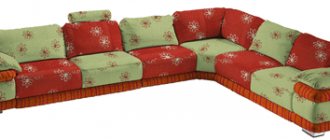English chair with ears: time-tested
from November 26, 2014
For hundreds of years, the majestic and elegant “chair with ears” has been decorating the homes of connoisseurs of comfortable furniture. This item is best known as the English high-back chair. However, it also has other names. In England itself it is called a “wingback chair”: a back with wings or a winged chair. We usually call these protruding elements of the back ears, but the French decided that they look like cheeks. Definitions for the chair such as “fireplace” and “grandfather’s” have also taken root. In Russia for a long time it was called “Voltaire”, because in the era of the great philosopher this furniture became most widespread in Europe. The chair is over three hundred years old, so it is not surprising that it has acquired many names.
Main features of a classic English style chair:
- Low curved wooden legs;
- High back;
- Wings on the sides of the back, turning into armrests;
- Deep seat.
The wings are large and not very large, straight and curly, similar to the wings of a butterfly and bat.
There are many design variations: the chair can be smooth and quilted, with wooden and upholstered armrests, with a straight and rounded back, etc.
Video
In this article we will consider the topic of making classic furniture for almost all apartments and houses - a do-it-yourself chair. This solid wood chair with armrests will not be bulky and the best use for such a product is in dining rooms. Following these instructions, you can do it at home.
The production of the chair will take place in several stages. All of them will be presented below and you can easily make it in a few evenings if you have the tools and materials, because all the schemes will be presented below. There will be no ready-made drawings in this article, since everything is done from improvised means: from boards, plywood bars, which are available.
History of the English armchair with ears
Similar models have been known for a long time. But the seat closest to the classic English chair appeared only in the 17th century. Initially, these were rather rough chairs made entirely of wood, without filling or upholstery. Ears or wings were intended to shelter the person sitting from the wind and drafts.
By the way, English chairs with a high back are called fireplace chairs . Thanks to its design, the chair not only protects against cold air flows, but also retains heat from the fireplace. Writers of the Victorian era, painting an idyllic picture of family life, often mentioned a blazing hearth and fireplace chairs with wings.
But let's go back to earlier times. The winged chair became widespread at the beginning of the 18th century. In the era of Queen Anne Stuart, it acquires elegance. He gets padding. It is not for nothing that this model is often called a Queen Anne style chair .
Closer to the 19th century, the chair became soft - they began to fill it with horsehair. Expensive upholstery materials are used: velvet, brocade, embroidered fabrics.
French furniture makers borrow the now popular shape and add wings to the classic bergere chair . This is a very elegant French armchair with armrests, a high seat cushion and curved legs. It is distinguished by smooth curves. Initially, “bergeres” did not have any wings or, as the French said, cheeks. But, thanks to English influence, this family was replenished with a winged variation.
French armchair: with and without ears
In the Victorian era, the English armchair with ears and a high back became an integral part of the design of clubs and libraries. As a rule, for furnishing such interiors, preference was given to armchairs with leather upholstery.
In the 20th century, interest in classic English armchairs waned, but did not die out. Creators never stopped turning to historical styles, looking for inspiration in them and drawing ideas for their further processing. Thus, the famous Danish designer Arne Jacobsen in 1958 created an egg chair , with its high eared back reminiscent of a winged English model.
In recent years, armchairs with ears have come back into fashion. They find application in both classic and modern interiors. English-style armchairs are offered by manufacturers and sellers of both luxury furniture and mass-market furniture.
What are the chairs made of?
When choosing materials for a chair, it is necessary to take into account its specifics.
If you choose the swing chair option, then you will need thick fabric, different types of artificial ropes and pieces of wood.
To make a cocoon-shaped chair you will need rattan, willow twigs, bast, bird cherry or willow branches.
For a chair in the form of a nest, a hoop made of plastic or steel, durable fabric resistant to wear, synthetic filling, special cords for weaving, and various pieces of wood are suitable.
For the seat itself, the following techniques are used:
- Macrame;
- Patchwork technique;
- Knitting;
- Tatting.
Do not forget that the selected materials and fasteners correspond to the planned load.
Note!
Classic English armchair with ears in a modern home
In modern-style interiors, winged armchairs complement laconic minimalist sofas. And although these items are from different centuries, they combine perfectly and suit each other perfectly. An English-style high chair brings classic elegance to an urban-industrial minimalist space.
Today, mixed sets of furniture are relevant, that is, combinations of sofas and armchairs of different colors and styles. The high English chair is ideal for creating such furniture mixes, because it is both laconic and majestic. Thanks to this, it harmoniously complements both modern designs and furniture in the Rococo or Baroque style.
Armchairs with ears are popular for decorating spacious dining and dining areas. They are installed at the head of the table on one or both sides, combined with ordinary chairs. English-style seats make the dining area elegant and imposing.
A set of not too massive and not very high winged chairs can be used instead of traditional dining chairs.
A high wing chair, especially a leather one, is ideal for an office or library. This piece of furniture, together with other elements, adds solidity and visual high value to the interior (in the best sense of the word). It is very comfortable to work and read while sitting in such a chair - the deep seat and high back provide maximum comfort.
Manufacturing stages based on the model
The process of making a chair with your own hands directly depends on the chosen model. Homemade products may not even be inferior in comfort and appearance to their factory counterparts.
Traditional
A traditional chair is an excellent design solution for creating a comfortable environment in the home. Unlike sofas, armchairs take up much less space, and making them yourself from wood, chipboard or metal is faster and easier.
After preparing the tools, a location for assembly is selected. It is advisable that no one moves the laid out materials. It is important to consider side effects from the manufacturing process and their consequences for others. When cutting wood with a jigsaw, sawdust should not get on furniture or interior items, and when using inverter welding, you must adhere to fire safety requirements. When all preparations are completed, you can begin installation.
- using cardboard templates, transfer the layout of the parts onto the frame materials;
- use a jigsaw or grinder to cut elements along the lines of the drawing;
- if necessary, process open parts made of beams with a grinding machine;
- use a screwdriver or use a welding machine to fasten the frame parts;
- draw the upholstery pattern on the furniture fabric, cut it with 1 cm seam allowances, sew the parts;
- cut and cut furniture foam, fill upholstery;
- the armrests are wrapped in foam rubber and secured with a special stapler. Decorative wooden armrests, if necessary, are secured on top with a screwdriver and self-tapping screws.
If the wooden chair will be placed in a room with high humidity, after assembling the frame it should be treated with bioprotective agents.
After completing the installation work, you can decorate the chair to your liking. Furniture fabric is used to cover small buttons, which are sewn onto the product in a checkerboard pattern. By applying paints of different colors and sanding, wooden elements are decorated in an antique style with your own hands.
Folding
A folding chair is a great way to organize a place to relax. This piece of furniture, made for use in garden areas, is indispensable in the summer. A garden chair made by yourself will fulfill its functional purpose to the fullest and will not be inferior to factory-made analogues. The possibilities of using a folding piece of furniture allow it to be used in the most unexpected situations: overnight guests, moving, relaxing on the veranda. The wooden chair is made in a variety of styles. Having chosen a design and completed a drawing, you can begin assembly work:
- cut the prepared materials with a jigsaw or grinder to the required sizes;
- treat the surface with a grinding machine to make it smooth, otherwise sharp traumatic particles may separate;
- treat with bioprotective agents and dry well;
- paint all the parts in the desired color;
- assemble the chair frame using a screwdriver, self-tapping screws and the necessary fasteners.
Wooden chairs can be decorated to suit almost any style. Varnishes, paints and patinated enamels are used for processing.
The finished chair should definitely be checked for strength. If all points are performed correctly, a folding chair made of timber will last a long time.
From pallets
Construction pallets are assembled from flat boards that have dried and will no longer change their geometry. Nevertheless, their use as a material for making chairs yourself is widespread. Pallets make original loft-style models that are almost no different from designer options. Manufacturing includes several stages:
- After selecting the model and carrying out the preparation, the boards are sanded using a sanding machine. Without this process, the wood may delaminate.
- Using a jigsaw or grinder, the pallets are cut in half, the edges are sanded and painted over.
- From the elements you need to assemble a frame chair from boards of the desired shape, and then secure the elements with self-tapping screws and a screwdriver.
This DIY garden chair looks no worse than store-bought counterparts. For comfortable use of pallet seats, it is necessary to sew cushions on them. The fabric is selected based on the operating conditions of the furniture. As a filler you can use foam rubber, holofiber, synthetic padding polystyrene, polystyrene foam balls.
Features and characteristics of a fireplace chair with ears
It is not difficult to recognize a fireplace chair. It has a fairly recognizable appearance with characteristic features:
- Lateral support from bottom to headboard. This is what they call the ears;
- Wide selection of shapes. Similar options exist in a number of styles. For example, in Provence. They do not differ very significantly from each other, but still these signs are differences;
- A symbol of comfort and warmth of the hearth. It’s hard to imagine this chair without the accompanying crackling of logs in the fireplace;
- Great variety in external design. Each model is unique in its own way, despite small differences in shape;
- Constant standing on your feet. They themselves may vary in appearance, but they are always the classic 4 supports;
- Very often the sides and ears are one element.
In the interior
For many, on an unconscious level, Voltaire’s chair is associated with a throne, which makes them think about purchasing it. But for most people, associations and monarchs do not at all prevent them from equipping their home with comfortable and at the same time stylish furniture. It is important to note that each chair model will bear a separate imprint of its time. And finding your own option is not difficult. Some people like the modern style of the Voltaire chair, while others will look for a model dating back to the 19th century, and also will not go wrong by decorating their home with it.
Many publications describe Voltaire's fireplace chair as old-fashioned and unstylish. This is an incorrect judgment. The convenience of such furniture attracts not only older people. Modern youth are also actively purchasing similar furnishing options for country houses. Design experts say that the Voltaire chair will still be relevant in two to three hundred years.
The history of the appearance of a chair with ears
Two countries, England and France, are credited with creating this model. As often happens with furniture, similar ideas were born approximately simultaneously in different parts of the Old World. Now it is difficult to establish who first came up with the “eared” model of the chair. Louis XV celebrated his reign with the appearance of a large number of varieties of seats. Among them, special attention should be paid to the model called bergere. The armrests and back were a semicircular single structure without joints of parts. In appearance it is very reminiscent of a traditional English chair. A little later, they began to make the back straight, and also added those famous ears or wings (another name). In the English version it is very difficult to establish the specific period of the origin and spread of the English chair with ears. Presumably this is the heyday of colonial England. But the chair became widespread so quickly, thanks to its good protection from drafts, that now every Englishman will tell you that there have always been “eared” models. To this day, it is rare that a home can do without this option.
Classic soft product
Such a thing as a DIY soft chair requires a long preparatory stage. Materials you will need:
- Plywood 20 mm thick.
- Sandpaper.
- Electric drill.
- Sets of screws and thin nails.
- Electric jigsaw.
- Metal rims.
- Foam rubber.
- Joinery adhesive.
- Painting tape.
- Ruler, tape measure.
- Stain, glossy black dye.
- Pencil.
Now you can get started:
- Download the drawing of the chair you like, calculate the consumption of materials.
- Make cardboard templates to scale, transfer the outlines onto plywood, then cut out the pieces using a jigsaw.
- Clean and sand the surface of the wooden parts. Pay special attention to the end areas, soaking them well with drying oil.
- Paint or stain the sides. Reinforce the end parts of the sidewalls with metal rims. Secure the rims with screws.
- The next stage is covering the product. Start from the back of the back, using faux leather. Next, proceed to covering the remaining parts of the product. Secure the fabric with wallpaper nails.
Important! It is advisable to treat the fastening points with wood glue. The chair will turn out better.
Types of fireplace chairs
With the shapes of Voltaire's chairs, not everything is so simple. On the one hand there are many of them. But the differences between them are minimal. Excludes modern or designer chairs. Let's start with the basics:
- Bergere. This is a French version with a semicircular back. A bit like a shell. The sides are made slightly beveled, which only enhances the impression;
- Bergere with a curl. The ears have been replaced with a very original rolled edge. The back is slightly shortened and the maximum will reach the middle of the shoulder blades;
- Straight back. This is a classic English style chair. The sides are solid with ears. Located almost at right angles to the back or with a minimal bevel. Equipped with very narrow armrests;
- Provence. The principle is the same, but instead of armrests, the chair is equipped with comfortable wide bolsters. The sidewalls are made separately from the wings.
There are also a number of chairs on which the “eared ears” influenced the creation of a new design:
- Egg or swan. Arne Jacobson created as many as 2 chairs based on the English model. All of them were originally interpreted, but remained recognizable;
- Gaming chairs. Voltaire chairs became so famous for their comfort that the lateral support of gaming chairs became an extension of traditional ears. It only expanded downwards, receiving a second wing.
Master class on creating a chair
This is the simplest type of hanging chair that you can make yourself. To make it you will need:
- dense material – 2 m;
- wooden beam - length 1 m, radius 3 cm;
- several carbines (0.11 m), designed for a weight of up to 0.16 tons;
- cable with a diameter of 1-1.15 cm with a tensile load of up to 3200 kgf;
- paints, brushes, nylon threads.
The tools you will need are a drill, a sewing machine, an iron, scissors, and a ruler.
General structure of English fireplace chairs
Frame
To make the frame of traditional models, wooden blocks and furniture plywood are used. Less often it is replaced with particle boards. At the same time, the design is quite complex. What from the side looks like a flat sidewall with an ear inside is literally stuffed with bars that strengthen the structure.
Moreover, they are located not only along the contour, but also taking into account the diagonal stress. More modern types of chairs can use fiberglass (egg) or metal tubes (gaming).
Back and seat
The dimensions of the seats in the “eared” models are calculated according to two parameters. Taking into account the useful size and when measuring the overall width and depth. The first parameter usually does not exceed 60 cm for both values. The second is most often close to 90 cm. Also for both values. Height is also calculated according to two criteria.
The seat height above the floor is standard 50 cm, but taking into account the backrest, the value can reach 1.1 or 1.2 meters. For bergers this parameter is slightly lower. Their backrest rarely exceeds the threshold of 70 cm. They also have a low seat height. It usually barely reaches 40 cm. Bergeres are smaller and the general indicators of width and depth are smaller. Typically, these values are approximately equal to the height of the backrest.
Wood as the main material
Have you decided to make a chair and don’t know what materials to use? The best material is wood, namely boards, timber, furniture panels and other solid wood lumber. There are several reasons for assembling furniture from wood and among them:
- Easy wood processing
. Working with wood is easier than with other materials from which furniture is usually made. Again, the tools found in most home workshops will suffice for woodworking; - Affordable price
. Boards, timber and other lumber are still inexpensive considering how much is needed to make one chair. Moreover, you don’t have to buy lumber new, because there are used pallets; - Great looking wooden furniture
. The texture of the wood has a beautiful grain pattern, which, of course, will decorate the chair you assemble, provided that you cover it with a clear varnish; - Durability
. All-wood furniture is superior in reliability to furniture assembled from plywood or particle boards. With proper use, a chair made of wood will last at least ten years.
Which type of wood is preferable? For assembling furniture, I recommend lumber from hardwood: aspen, linden, birch and fruit trees. Coniferous wood is knotty and resinous, which will complicate cutting materials and finishing the finished product.
Model selection
Now that you know what materials to make a chair from, all that remains is to decide on the appropriate model. I offer a brief overview of popular options.
Regular chairs with armrests
– essentially, these are chairs, but more massive and more comfortable https://4authors.seoerp.ru/files/tinymce/img5b539aef94abb2.09760471
Chair for the garden
| Illustrations | Furniture options for furnishing a summer house |
| From pallets . This is the best option in terms of ease of assembly and low cost of materials. Again, with a competent approach to the assembly process, the finished products will look modern and stylish. | |
| Shell . Despite the complexity of the design, this chair looks great and provides the greatest comfort in comparison with other models. The only drawback of this option is the need to bend a lot of wooden parts. | |
| From an electrical cable reel. A cable reel with a back made of edged boards is furniture that is not only cheap, but also quickly made. It will be even easier to make such a chair than from pallets. In addition, thanks to its rounded sides, you can make a rocking chair from the bay. |
A set of standard questions for a self-taught furniture maker
Before we start making a chair, I will comment on the questions that self-taught furniture makers most often ask.
What to cut with?
For longitudinal cutting we use a circular saw, for transverse and curved cuts we use a jigsaw or hacksaw.
How to fasten wooden parts?
The design of the seats has heavily and lightly loaded joints. For heavily loaded connections we use bolts with washers and nuts. For lightly loaded connections we use wooden dowels or furniture confirmations.
Paint or varnish?
The choice of coatings depends on the quality of the lumber. If the wood has no visible defects, it can be tinted with stain and coated with clear varnish. If there are pigment spots on the surface or it was necessary to eliminate defects with putty, it is preferable to cover the part with primer and a continuous layer of paint.
How to reduce paint consumption?
Have you noticed that when finishing a chair, paint and varnish materials are absorbed into the surface and unpainted areas remain? The problem is that lumber has a porous structure and in order to reduce its absorbency, preliminary application of a primer or drying oil will be required.
Why do cracks appear?
Often, novice craftsmen, having made furniture from wood, discover cracks appearing over time. The reason for cracking of lumber is uneven drying. The solution to the problem is to use initially dry wood.
Preparing for work
At the preparatory stage, we select a suitable drawing, prepare materials and prepare tools.
I suggest using wooden pallets rather than new purchased boards as materials. One and a half pallets will be needed for one country chair. Considering that used pallets are sold for about 300 rubles, the price of assembled furniture will be low.
Now let's select a drawing. The diagram shows the dimensions oriented to the structure of a person of average height. If necessary, the dimensions can be revised up or down.
This drawing shows several views of the chair, namely top, front and side views. The location of the fastening hardware, which ensures a reliable connection, is also shown.
The process of making a chair with your own hands: step-by-step instructions
I offer step-by-step assembly instructions. To make it easier to repeat the above steps, the instructions are presented in the form of a photo report. The steps are listed in the order in which the work needs to be completed.
Make yourself comfortable. On a cult chair. And contemplate the beauty of nature. The Adirondack chair is a symbol of luxurious and comfortable country life. You don't even have to buy it - now you can make this wooden chair for your garden and home with your own hands!
English armchair with ears
This comfortable chair is a unique piece of furniture! You can sit in it for hours, relax, watch TV or read. Unsurpassed in moments of relaxation, thanks to its shape, it guarantees comfort. It should be soft and pleasant to the touch. High chair with ears - this name is quite funny, but it fully reflects the shape of this furniture. This project is many years old, but it still attracts with its elegant appearance, practicality and comfort.
How to make a soft chair with your own hands for a children's room?
Making a frameless soft chair for a children's room is no more difficult than a regular bean bag chair. The only difference is in color.
Important! It is better to choose a bright fabric that encourages positivity and cheerfulness. Shades should not be too “screaming” and annoying.
Here is one of the options for upholstered furniture in a child’s room:
- The frame chair can be made in the form of a semicircular sandwich. Hardboard is used for the back wall, plywood is used for the front wall.
- Carefully glue the furniture foam onto the base, on top of which the upholstery will lie.
Important! The best upholstery material options are flock or eco-leather. Even if a young artist paints the upholstery with felt-tip pens or paints, you can remove the marks completely.
- The maximum height of a baby seat should not exceed 600 mm.
English chair with ears - what is it and where did it come from?
At first glance, the design of this piece of furniture appears to be modern, with a touch of retro elegance, but its history is long and rich. The first models appeared in French courts in the eighteenth century. Although this chair is reminiscent of the English gentleman's style, its first design dates back to the era of Louis XIV.
It was a piece of furniture intended for the elite. It is worth remembering that this is not just a decorative element, but also a very practical one. “Ears” protect from drafts. The high back and massive seat of the English chair have become an indisputable example of comfort. In the twentieth century, two iconic chairs were created based on the eared one, the Egg Chair by Arne Jacobsen, and the second is the Wingback Chair by Tom Dixon.
The eared chair gained recognition and fame not only for its specific shape, but also for its practical advantages. Its design is quite narrow, but it is quite tall. At the height of the head, the so-called ears or in English: wings protrude on the sides. This charming detail protects you from drafts, its shape accumulates heat, for example, coming from the fireplace, next to which it is often placed. Therefore, it is often also called a fireplace chair with ears. In modern times, this model has received several implementations inspired by classical forms.
Manufacturing
An English chair is easy to make with your own hands. You can create any model so that it is not bulky, the size can be adjusted to suit the situation.
For work, you can use waste materials: plywood, bars, boards. For upholstery, any fabric or eco-leather can be purchased. It will take several evenings to make.
Step-by-step instructions for any model can be found on the Internet. Having made the frame, you need to wrap it with foam rubber and stretch the upholstery. It is convenient to fasten the fabric with a furniture stapler. Decorative elements are your desire and imagination.
I will list the 5 main stages/steps of making a chair:
| Bergere with ears | |
| Bergère Marie Antoinette | |
| Bergere with lambrequin | |
| Bergere pompidou | |
| Provence armchair |
| Photo | Description |
| Step 1. Frame |
The frame dimensions can match your chair.
Weaving of textile straps is used for the back and sides.
A padding polyester is placed on the seat and covered with a thin layer of foam rubber
Having covered the seat, proceed to the sides.
The back is made like the seat - foam rubber or padding polyester.
Which eared chair to choose?
The classic fireplace chair with ears is widely known, however, various versions are available for sale.
In order for this piece of furniture to be used for many years, it must be of the highest quality. The material used for the upholstery is important. There is a choice of upholstery fabrics - cotton, linen, polyester, viscose, or even leather - that are durable, stain-resistant and easy to clean, provided the materials are of good quality.
Each type of fabric requires different care. In the case of cotton, linen or synthetic fibers (polyester, viscose), gentle products are sufficient with which you can quickly get rid of any dirt. Plush and suede upholstery requires slightly different care - water with ammonia, for example, is enough to remove dirt.
The following important parameters should be considered when deciding on your final choice. The seat can be quilted, which creates the impression of elegance and English chic, or regular, which in turn can be more comfortable. The frame should provide excellent support for the body. Noble materials would be oak or exotic wood, such as teak. Of course, there are also offers made from other, cheaper materials.
When purchasing, sit in the chair and check whether the amount of support and softness of the seat are sufficient and provide comfort.
Materials of manufacture and types of legs
The element of furniture that attracts attention is the legs. They are:
- Straight. The classic version has no bends, the same average thickness, the height does not change.
- Curved. There are even two bends, the legs resemble the letter S. It is characterized by abundant decor in the form of wood carvings. The legs are chiseled, rather thin, slightly thicker at the bottom, turning into some kind of animal paw. This chair looks very elegant and graceful.
- Slanted. They are attached to the body at a slight angle and can be flat or drop-shaped. They look quite massive. On modern models, they are often made of chrome-plated steel.
- Combined. The front legs are curved, richly decorated, the hind legs are simple, straight. The chair looks most impressive when viewed from the side.
- Globular. They are mounted only on Bergers; they are short and straight. A small hemisphere rests on the floor.
- In the form of stands. Such elements are used for the “Egg” and “Swan” chairs. The single straight leg, gradually expanding, turns into a semicircular (less often cruciform) base.
- In the form of a cross. Option exclusively for gaming chairs. They have one leg and a five-pointed crosspiece on wheels.
The frame of classic fireplace chairs with “ears” is made of solid wood (birch, pine, ash, beech, larch), so they are massive and cannot be cheap. For elite models, oak, rosewood, mahogany, and teak are used. Chairs of modern design have a metal or fiberglass frame. Craftsmen who want to make a piece of furniture themselves often replace wood with plywood, fiberboard or chipboard.
The procedure for making a rocking chair from different materials with your own hands
Direct
Curved
Oblique
Combined spherical
In the form of a stand
In the form of a cross
The main requirements for upholstery are strength and tensile strength. The following materials are used to make chairs:
- Genuine Leather. When using it, an already expensive chair becomes even more expensive. The material is wear-resistant, easy to care for, but is resistant to scratches and shrinks when exposed to heat. You should not place it so that the fireplace portal is very close and directly opposite.
- Faux leather. In terms of presentation and performance characteristics it is not inferior to natural ones, but costs significantly less. Often has a special coating that protects it from water and dirt.
- Tapestry. Cotton fabric of very dense weaving with complex patterns lasts a long time without losing its presentability, only the colors fade slightly.
- Flock. Mostly synthetic with the addition of natural fibers. Affordable, the surface is soft and pleasantly fleecy to the touch. A definite plus is the wide variety of textures and colors. The upholstery will not be damaged if there is a cat or dog in the house.
- Velours. The texture resembles flock, but it looks more solid and noble, but it is difficult to care for, wears out quickly, and gets dirty easily.
- Jacquard. Material with a dense embossed texture. It consists of multi-colored threads that form beautiful patterns or designs. It is wear-resistant and durable.
- Chenille. Very dense fabric with short pile, consists of a mixture of natural and synthetic fibers.
- Microfiber. An analogue of natural suede, it has a special Teflon coating to protect against pet claws. The fabric is wear-resistant and pleasant to the touch.
Since fireplace chairs are relatively narrow, almost the entire seat and back are in contact with the human body. With frequent use of a piece of furniture, soft “loose” fabrics (velvet, velor, wool) quickly wear out and it loses its presentability.
Genuine Leather
Faux leather
Tapestry
Flock
Velours
Jacquard
Chenille
Microfiber
What kind of interiors is a fireplace chair with ears suitable for?
It's amazing how such a specific piece of furniture can harmoniously combine with interiors in different styles.
- The most obvious thing for him will be a classic, elegant interior, reminiscent of palace halls.
- If the upholstery of the chair is light, it will look good in a romantic interior and create coziness in a Provence style room.
- Leather upholstery will suit a more modern design and will look great in retro and art deco style rooms.
- In an eclectic style interior, a wing chair in a strong color will occupy a distinct place and can act as an original counterpoint.
- Models made in patchwork style are designed for lovers of bohemian and oriental style.
- More whimsical designs are reserved for homes that are decorated in a boho style.
There is no need to have a luxurious home to experience the comfort and convenience of a native of the upper classes. Just one eared chair can redefine the character of your home interior. It is ideal for relaxing in the afternoon or evening while reading your favorite book.
What it is?
Modern Spanish style is a set of bright design techniques used to create a temperamental color for a residential interior. The Spanish direction brings with it bright colors, a sense of celebration, an abundance of sun and unity with nature. To create a Spanish interior, you will need to turn to the origins of the colonial style.
The features of this direction include the following factors:
- the bright color palette and combination of soft tones create a feeling of light, warmth and comfort;
- large windows allow daylight to enter the room, flooding it with sunlight;
- the use of ornaments and accessories allows you to place visual accents where necessary;
- natural materials are used in the interior - wood, stone, glass, metal;
- The design skillfully combines simplicity and luxury.
Expressive and bright contrasts attract the attention of people who want to transform their home in a fashionable design direction
Spanish style in interior design is usually divided into 2 types.
Modern look. The direction has undergone a slight transformation - the combination of antiquity and modern elements made it possible to achieve a unique final result.
The peculiarity of the rustic flavor can be emphasized with the help of ceiling beams, which are left for viewing, painted in light colors.
Where to put the chair?
Traditionally, its place was near the fireplace. It is here that, creating a harmonious pair with the footrest, it provides a comfortable place for a pleasant evening rest. If you don't have a fireplace, it is usually placed in the living room, where it creates a corner for relaxing and reading books. It can also be present in bedrooms, dens and offices.
Furniture with history, classics of world design. It also happens that one such element determines the entire character and style of the interior and emphasizes the taste of the owner. A chair with ears is certainly one of these pieces of furniture. This elegant chair is synonymous with class and elegance.
When arranging a room, you should follow a single style or leitmotif and consistently choose furniture and accessories. Here are some fashionable styles that the ear chair fits into:
- Vintage style . For people who love memories. This is where furniture with classic shapes (such as the English chair) and expressive additions come in handy: a large cuckoo clock, wrought iron chandeliers and old-school lamps reminiscent of headlights.
- Shabby chic : The style is delicate, feminine and subtle. The dominant colors here are: white, ecru, pale shades of pink or light blue. Romantic decors play an important role in this style: motifs of hearts, angels and floral patterns. A chair with ears, covered with material in subtle patterns, will show itself perfectly here.
- Boho style : This interior is full of energy, intense colors and patterns, oscillating between eastern influences and artistic bohemianism. An eared chair in bold colors placed in the corner will add character to the room.
- Glamor style : This interior is inspired by the Golden Age of Hollywood. It is dominated by luxurious fabrics, plush upholstery, satin pillows, silk curtains and phenomenal objects. Every lady will appreciate a luxurious eared chair.
- Provence style : in an interior decorated in this style, antiques, herbs, lavender, openwork curtains, embroidery and frills, as well as a classic English chair will look great.
Wooden chair for a summer house
Here’s another interesting option: a DIY wooden chair. Wood is a practical, beautiful and durable material, which, moreover, can be easily processed. In addition, wood has the following advantages when making home or country furniture yourself:
- Availability of a variety of lumber, their relatively low cost.
- Naturalness, environmental friendliness.
- Pleasant smell of wood. Coniferous wood smells especially pleasant.
- Unique wood texture.
Important! It must be taken into account that the conditions in which country furniture is located, if not extreme, are close to them. Therefore, you need to pay special attention to treating parts with an antiseptic. In this case, the furniture will serve you much longer.
Pine, spruce, ash, oak, larch or beech are best suited for home furniture production. Parts that are not subject to heavy loads can be made from linden or alder.
So, we make a garden chair with our own hands. Choose simpler drawings to begin with. When choosing a design, follow two “golden rules”:
- Choose the design that is completely clear to you. Mentally work through the entire procedure. Prepare in advance the tools that are convenient for you.
- Consider the place where the furniture will be used and the design of the room into which this furniture will fit. For example, the best option for a summer house is a folding product or an antique rocking chair.
Manufacturing procedure
Let's consider a simple model, which consists of the following components:
- Sidewalls – 2 pcs.
- Drawers – 3 pcs.
- Cross slats – 35 pcs.
It is these 35 slats that will form the surface of the seat.
The most difficult part of the work is cutting out the side parts:
- First, make a pattern on cardboard and only then, after making sure that the actions are correct, transfer the outline to the material. The best option for making sidewalls is plywood with a thickness of 3 cm. Use an electric jigsaw to cut out parts.
- Sand the end parts of the sidewalls. Using a hand router or grinder, remove the chamfers.
- Now cut out 3 drawers from plywood. The length of each is 120 cm, width - 10 cm. Sand these parts; there is no need to chamfer.
- From a 50x25 mm block, cut 35 sections, the length of each of which is 120 cm. Next, as usual, comes sanding and chamfering. For fastening, prepare 12 confirmations 5x120 mm and wood screws 4x45 mm (40 pieces).
- Mark the places for attaching the drawers. There are 3 of them in total: in the foot, head and in the middle of the outer arcs of the sidewalls. Drill through 8 mm holes for the drawers.
- Pull the side parts of the product together with three drawers. For holes in the end parts of the frames, use a 5 mm drill.
- Now fasten the pre-prepared pieces of bars to the seat using self-tapping screws.
- The final stage is covering the holes and cracks with wood putty. After this, sand the product, prime the surfaces and paint with varnish or acrylic paint.

